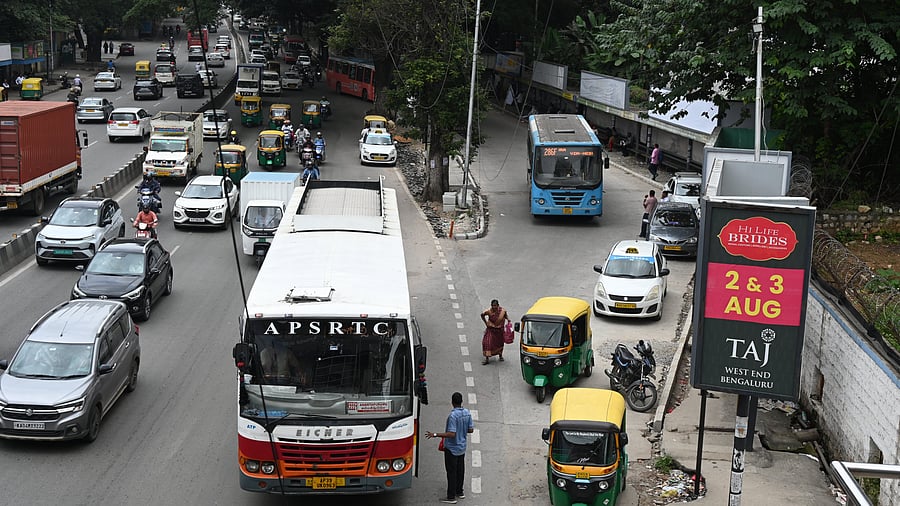
Currently, Bengaluru has around 20 bus bays, according to BBMP officials.Seen here is a bus bay near Mehkri Circle.
Credit: DH Photo/ B K Janardhan
Bengaluru: Bus bays have been hailed by mobility experts and traffic officials for helping reduce Bengaluru’s growing problem of traffic congestion. However, the implementation has been lacking. Additionally, the ones that exist are often misused.
Currently, the city has about 20 bus bays, as per BBMP officials. Unlike a regular bus stop, usually located at a footpath by the road, a bus bay is a designated stop on the side of the road, which allows buses to pull out to pick up and drop off passengers, without hindering the flow of traffic.
When DH paid a visit to a few bays across the city for a reality check, the result was a mixed bag.
The bus bay at Sirsi Circle turned out to be the most efficient — with BMTC buses diligently pulling in at the stop. The bay is spacious enough to accommodate three buses at once. However, the bus bay only exists on one side of the road; on the other side, buses stop along a narrow footpath near a mall’s entrance. The situation is quite similar in Mehkri Circle.
Noor, a physical therapy student and regular commuter from Sirsi Circle, said, “Buses always use the bay; if they don’t, it creates major traffic because the roads are narrow.” She added that if more than three buses arrive at once, it leads to mild congestion at the spot.
In comparison, the bus bay on Residency Road, located close to the Bishop Cotton Boys’ School, is much smaller in size. This narrow bay offers only a slight road deviation for buses to halt. While most buses do stop here, during school dispersal, the crowd spills into both the road and the bay, forcing buses to halt mid-road and causing minor jams.
One of the busier junctions, Benniganahalli, features a large, functional bus bay close to the metro station. The bus bay is efficient and is long enough to hold up to five buses and wide enough to accommodate more buses in parallel. However, the bay on the opposite side, toward Baiyappanahalli, sees inconsistent use. Buses sometimes skip the bay due to blocked entry points, stopping instead on the main road. When exiting the bay, buses often merge abruptly into traffic, causing recurring jams every couple of minutes.
Another consistent issue leading to the inefficient use of bus bays is auto drivers who misuse the bay. This seemed to be an issue at the bays in Residency Road, Vasanth Nagar, and BEL Circle, going towards Vidyaranyapura.
At the bays in BEL Circle, the buses rarely move into the bay. “The bay is often filled with commuters and auto drivers. Plus, the bus drivers are usually in a hurry and end up stopping mid-road,” shared a regular commuter.
What goes wrong…
It is tricky to restrict the use of the off-line bus stops only to buses, said M Lokesh, BBMP chief engineer. “It’s not possible to constantly keep an eye on whether autos and other private vehicles are parked at the bays. The commuters must be aware that the stops are only meant for buses. We can’t set up any barricades because that’ll only add to more traffic problems,” he added.
“We’re aware that they’re useful. However, with Bengaluru roads being quite narrow, it can be difficult to accommodate the bus bay. If the bays are not planned properly, it can end up adding to the problem, rather than solving it. Recurring traffic congestion becomes an issue. We’re looking into where the bus bays are most suitable,” Lokesh told DH.
While it can prove to be difficult to build bus bays in pre-existing congested areas, the bays must be a must in newer localities, said traffic expert M N Sreehari.
“These bays are necessary to ensure the safety of passengers. But due to poor urban planning, it has become difficult to accommodate these buses in the city. However, the authorities have no excuse for not including the bay in the newer bus stops across the newer extensions and layouts. It is the shortsightedness of our officials,” he elaborated.
Bay, shelter or lane?
Bus bay: A bus bay is a designated stop on the side of the road, with a carved path that allows buses to pull out from the traffic flow without disrupting it.
Bus stop / shelter: Often located by a footpath, this is where buses stop in the middle of the road. It often causes traffic congestion.
Bus lane: This is a designated traffic lane reserved for buses to improve their speed and reduce congestion.
BBMP shortlists new locations
The Bruhat Bengaluru Mahanagara Palike (BBMP) is currently working towards building more bus bays. Some of the locations shortlisted by the BBMP include the CNR Rao Junction Mekhri Circle J P Nagar (near Raghavendra Swamy Mutt) and K R Puram (near ITI factory). Hailing the concept M A Saleem DG & IGP Karnataka said the bays have proven successful in reducing traffic issues in multiple locations including Nrupathunga Road and Ambedkar Road. “Introducing these bays on Kempegowda Road and MG Road (towards Trinity Circle) would be quite beneficial” he told DH . A senior BMTC official believes the city requires at least 200 bus bays. “The bays have been very helpful. If the BMTC is planning more we’d be happy to help with identifying the required bus bays” he said.
Many remain non-functional
While the BBMP has around 20 documented bus bays across the city not all of them are fully functional. Some have been dismantled due to ongoing road and metro work a BBMP official said. Popular bus bays include: Mehkri Circle (towards Hebbal)
Benniganahalli
Silk Board
Jayanagar 4th Block
KR Puram Railway Station
Tin Factory